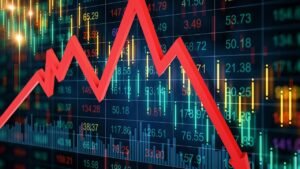Latest Economic News & Market Updates | Global Insights.
Keeping up with economic news is a big deal if you want to do well with your money. It’s like trying to drive without looking at the road, you’re bound to hit something. The world of finance moves fast, and what’s good today might be bad tomorrow. So, understanding the basics of what’s happening with the economy, from how much things cost to how many people have jobs, can really help you make smarter choices. We’ll look at how to get this info and what to do with it.
Thank you for reading this post, don't forget to subscribe!Key Takeaways
- Watch how prices are changing and what that means for your money.
- Understand if the economy is growing or shrinking by looking at GDP.
- Know where to find reliable news sources for economic updates.
- Use economic data to help you make better investment choices.
- Learn from successful investors and how they use economic news.
Understanding Key Economic Indicators

Keeping tabs on the economy isn’t just for economists or big-time investors. For anyone trying to make sense of the financial world, understanding a few core economic indicators is pretty important. Think of them as the vital signs of the economy – they tell you if things are healthy, growing, or maybe a bit under the weather.
Monitoring Inflation Trends
Inflation is basically how much prices are going up over time. When inflation is high, your money doesn’t buy as much as it used to. It’s like everything from your groceries to your gas gets more expensive. Watching inflation helps you understand purchasing power and how it might affect your budget. A steady, low inflation rate is generally seen as good, but when it spikes, it can cause a lot of worry.
- Consumer Price Index (CPI): This is a common way to measure inflation by tracking the average change over time in the prices paid by urban consumers for a basket of goods and services.
- Producer Price Index (PPI): This measures the average change over time in the selling prices received by domestic producers for their output. It can sometimes be a leading indicator for CPI.
- Personal Consumption Expenditures (PCE) Price Index: This is another inflation measure, often preferred by the Federal Reserve, that tracks price changes for goods and services bought by consumers.
Keeping an eye on these numbers helps paint a picture of price stability, or lack thereof, in the economy.
Analyzing GDP Growth
Gross Domestic Product, or GDP, is the total value of all goods and services produced in a country over a specific period. It’s a big picture number that tells us if the economy is expanding or shrinking. When GDP is growing, it generally means more jobs and more business activity. If it’s shrinking, that’s usually a sign of a slowdown or even a recession. We often see GDP reported quarterly, and it’s a key figure for economic indicators.
Here’s a quick look at what GDP growth can mean:
- Positive Growth: Indicates an expanding economy, often leading to more employment and higher incomes.
- Negative Growth (Recession): Suggests the economy is contracting, which can mean job losses and reduced business investment.
- Stagnant Growth: The economy isn’t really growing or shrinking; it’s just kind of staying put.
Tracking Unemployment Rates
The unemployment rate shows the percentage of the labor force that is jobless and actively looking for work. A low unemployment rate is usually a good sign, meaning most people who want a job can find one. High unemployment, on the other hand, points to economic struggles. It affects consumer spending and overall business confidence. When unemployment is low, people have more money to spend, which helps businesses do better.
- Unemployment Rate: The percentage of the labor force that is unemployed.
- Nonfarm Payrolls: This report shows the number of jobs added or lost in the economy, excluding farm workers, private household employees, and non-profit organization employees. It’s a very closely watched jobs report.
- Labor Force Participation Rate: This shows the percentage of the working-age population that is either employed or actively looking for work. A rising rate can be positive, even if unemployment stays the same.
Leveraging Reputable News Sources
In today’s market, just knowing what’s happening isn’t enough. You need to know where to get reliable information. It’s easy to get lost in the noise, so picking the right sources makes a big difference.
Subscribing to Financial Publications
Think of these as your go-to guides. Publications like The Wall Street Journal or Bloomberg offer deep dives into economic events and company performance. They often have dedicated sections for market analysis and economic trends. Reading these regularly helps you build a solid base of knowledge.
Following Industry Experts on Social Media
Many economists and financial analysts share quick takes and real-time observations on platforms like Twitter. It’s a fast way to catch breaking news or expert opinions. Just remember to follow people who actually know their stuff and have a good track record. It’s like having a direct line to some smart people, but you still need to think for yourself.
Utilizing Market Analysis Reports
These reports, often put out by research firms or investment banks, can be goldmines. They usually look at specific industries or sectors and give you data-backed forecasts. While sometimes they cost money, many are accessible through brokerage accounts or financial news sites. They can help you spot trends before they become obvious to everyone else.
Getting your information from a variety of trusted places helps you see the bigger picture. Relying on just one source can give you a skewed view of what’s really going on in the economy.
Here’s a quick look at some common sources:
- Financial News Networks: Great for live updates and immediate reactions to news. Think CNBC or Fox Business.
- Online Financial Publications: Offer more in-depth articles and analysis. Examples include Forbes, Reuters, and MarketWatch.
- Market Research Reports: Provide detailed data and forecasts for specific sectors or industries. Often found via financial data providers or research firms.
Navigating Market Trends for Investment Success
Identifying Investment Opportunities
Keeping up with what’s happening in the economy is pretty important if you want your money to grow. Think about it – if you know which sectors are expanding or which consumer habits are changing, you can spot places where your money might do well. It’s not just about picking stocks; it’s about understanding the bigger picture. For instance, if you see a trend towards renewable energy, that might point to good opportunities in companies working in that space. Paying attention to these shifts can help you find investments before everyone else does.
Minimizing Investment Risks
Markets can be unpredictable, and that’s where knowing the trends comes in handy for avoiding problems. If you’re aware of potential economic slowdowns or industry-specific issues, you can adjust your investments to protect yourself. Maybe it means not putting all your money into one type of asset or diversifying into areas that are less affected by current economic headwinds. It’s like checking the weather before a trip; you want to be prepared for whatever might come your way.
- Watch economic indicators: Keep an eye on things like inflation and job numbers. They tell you a lot about the economy’s health.
- Read industry reports: See what’s happening in specific business areas you’re interested in.
- Consider global events: International news can impact markets more than you might think.
Sometimes, the best way to manage risk is simply to understand what you’re investing in and why. Don’t just follow the crowd; do your own homework.
Maximizing Investment Returns
Once you’ve identified opportunities and managed your risks, the next step is making sure your investments work as hard as possible for you. This means understanding how current trends can lead to growth. If a particular technology is becoming more popular, companies involved in it might see their value increase. By aligning your investments with these growing trends, you increase the chances of seeing better returns over time. It’s about being smart and strategic with your capital.
Staying Informed in a Dynamic Market

Markets today move at lightning speed. What was a sure bet yesterday might be a shaky proposition now. That’s why keeping your ear to the ground isn’t just a good idea, it’s pretty much required if you want to do well.
Adapting Business Models to Market Needs
Businesses that don’t change get left behind. Think about how many companies had to shift online during the pandemic. It wasn’t just about having a website; it was about rethinking how they interact with customers and deliver their products or services. Staying current means watching what customers want and what competitors are doing. Are people suddenly looking for more sustainable options? Is a new technology making old ways of doing things obsolete? Being ready to pivot is key.
Gathering Customer Feedback for Insights
Your customers are a goldmine of information. They’re the ones actually using what you offer. Are they happy? What are they complaining about? Simple surveys, direct conversations, or even just paying attention to online reviews can tell you a lot. This feedback loop helps you spot problems early and also find new opportunities you might not have thought of yourself. It’s about listening to the market directly.
Monitoring Competitive Landscape
It’s not enough to just focus on your own business. You need to know what everyone else is up to. Who are your main rivals? What new products are they launching? Are they running special promotions? Keeping an eye on them helps you understand where you stand and what you might need to do to keep up or get ahead. Sometimes, seeing what a competitor does well can give you ideas for your own business. You can find good analysis on sites like IBD’s stock research tools.
The market is always talking. The trick is learning to listen to all the different voices, not just the loudest ones. This means looking beyond the headlines and digging into the details that really matter for your specific situation.
The Role of Data in Economic News
Looking at numbers might not sound like the most exciting thing, but honestly, it’s how we make sense of what’s happening in the economy. Economic news isn’t just about headlines; it’s built on data. Think of it like putting together a puzzle – each piece of data, whether it’s about jobs, prices, or how much stuff we’re making, tells us something important.
Using Data Analytics Tools
These days, there are tools that can sift through mountains of information way faster than any person could. They help spot patterns we might miss. For example, you can use them to see how consumer spending has changed over time or how different regions are performing economically. It’s about making the raw numbers tell a clearer story. Many businesses now use these tools to get a better picture of the market, helping them make smarter choices about where to invest or how to adjust their operations. It’s really changed how we approach business decisions.
Interpreting Economic Data
So, you’ve got the data, now what? That’s where interpretation comes in. It’s not enough to just see that inflation went up; you need to understand why and what that might mean for your money or your business. For instance, a rise in the unemployment rate might seem straightforward, but looking at the details – like which sectors are losing jobs – gives a much richer picture. Understanding the context behind the numbers is key to making good decisions. It’s like reading between the lines of a report. We’ve seen concerns raised about the quality of official U.S. economic data, which makes careful interpretation even more important [9ba0].
Anticipating Market Movements with Data
By watching how different economic indicators move, we can start to guess what might happen next. If we see a steady drop in manufacturing output, that could be a sign that businesses are slowing down, which might affect stock prices or job availability down the line. It’s not about predicting the future with certainty, but about making educated guesses based on what the numbers are showing us right now. This helps people prepare for changes, whether they’re planning investments or just managing their household budget.
Here’s a quick look at some key indicators and what they generally suggest:
- Gross Domestic Product (GDP): Shows the overall health of the economy. Growing GDP usually means things are good; shrinking GDP can signal trouble.
- Inflation Rate: Measures how fast prices are rising. High inflation can reduce buying power.
- Unemployment Rate: Indicates the percentage of people looking for work but can’t find it. A low rate is generally positive.
Making sense of economic news means looking beyond the headlines and digging into the data. It’s about connecting the dots between different reports and understanding the story the numbers are trying to tell. This approach helps in making more informed choices, whether you’re managing a business or planning your personal finances.
Mastering Investment Strategies with Economic News
Staying informed about economic news isn’t just about knowing what’s happening; it’s about using that knowledge to make smarter investment choices. Think of it like this: you wouldn’t go on a road trip without checking the weather or traffic, right? The same applies to your money. Understanding the economic landscape helps you see where opportunities might be and where potential problems lie.
Learning from Billionaire Investment Insights
Billionaires often have a different perspective on markets, shaped by years of experience and access to information. They tend to focus on long-term trends and value, rather than short-term fluctuations. Paying attention to what successful investors say can offer clues about where to look for growth. It’s not about copying them, but about understanding their reasoning. For instance, many successful investors look for companies with strong balance sheets and clear competitive advantages, even when the broader market is shaky. You can get insights on hot topics and the latest trends in the financial market with the BlackRock Investment Institute’s Weekly Commentary.
Implementing Smart Money Strategies
“Smart money” refers to the capital managed by institutional investors, hedge funds, and other sophisticated players. These groups often have resources to conduct deep research and react quickly to economic shifts. Observing their general movements, like increased activity in certain sectors or a shift towards defensive assets during uncertain times, can be informative. It’s about recognizing patterns that suggest where informed capital is flowing. This often involves looking at:
- Sector rotation: Moving money between different industries based on economic cycles.
- Asset allocation: Adjusting the mix of stocks, bonds, and other assets.
- Risk management: Employing strategies to protect capital during downturns.
The key is to connect the dots between economic reports and how these large players might be positioning themselves. It’s a continuous learning process.
Navigating Trading Floor Risks
The trading floor, whether physical or virtual, is where a lot of economic news gets translated into market action. Understanding the psychology and common pitfalls can help you avoid costly mistakes. For example, herd mentality can lead many investors to buy or sell at the wrong times, amplifying market swings. Being aware of this can help you stick to your plan. It’s also important to manage your own emotional responses to market volatility. Remember, not every piece of news requires an immediate reaction. Sometimes, the best strategy is to wait for more clarity before making a move.
Wrapping It Up
So, that’s the rundown. Keeping tabs on what’s happening in the economy isn’t just for the pros anymore. It’s about making smarter choices, whether that’s with your paycheck or your investments. We’ve looked at a few ways to stay in the loop, from checking out reliable news sites to just paying attention to the big economic numbers. It might seem like a lot, but even small steps can make a difference. Try to make it a habit, and you’ll probably find yourself feeling a lot more confident about where things are headed.
Frequently Asked Questions
Why is it important to follow economic news?
Following economic news helps you understand how the economy is doing. This can guide you in making smart choices with your money, like deciding where to invest or how to spend. It’s like having a weather report for your finances, helping you prepare for sunny days or storms.
What are some good places to get reliable economic news?
You can trust well-known financial news sites like Bloomberg or The Wall Street Journal. Also, following experts on social media or reading reports from market analysts can give you helpful tips and insights into what’s happening.
How can economic news help me invest better?
By understanding economic news, you can spot good chances to invest your money. For example, if the economy is growing, it might be a good time to invest in stocks. Knowing this helps you make more money and avoid losing it.
What are economic indicators and why do they matter?
Economic indicators are like clues that tell us about the economy’s health. Things like GDP (how much stuff a country makes), inflation (how prices are changing), and unemployment rates (how many people have jobs) are important. Watching these helps you guess what the market might do next.
How can I use data to understand the economy?
You can use tools that analyze data to see patterns. By looking at numbers about the economy, you can figure out what might happen in the future. This helps you make smarter decisions about your investments and business plans.
What’s the best way to keep up with changes in the market?
To stay ahead, you need to keep learning. Listen to successful investors, learn from their strategies, and be ready to change your plans if the market shifts. This way, you can handle risks better and make your investments grow.













